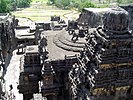Wikipedia:Today's featured article/December 30, 2015
The Rashtrakuta dynasty ruled large parts of the Indian subcontinent between the sixth and tenth centuries. Early Rashtrakuta inscriptions show their clans ruling from Manapura, a city somewhere in Central or West India, and from modern-day Kannauj in Uttar Pradesh and Elichpur in Maharashtra. This third clan overthrew Kirtivarman II and built an empire as the Rashtrakutas of Manyakheta, rising to power in South India in 753. At the same time the Pala dynasty of Bengal (in eastern India) and the Prathihara dynasty of Malwa (in the northwest) were gaining force. Each of these three empires annexed the seat of power at Kannauj for short periods of time while struggling for the resources of the rich Gangetic plains. At their peak the Rashtrakutas of Manyakheta ruled a domain stretching from the confluence of the Ganges and Yamuna rivers in the north to Cape Comorin in the south. The early kings of this dynasty were Hindu, while the later kings were strongly influenced by Jainism. The empire was known for its literary and architectural achievements, including the Kailasanath Temple at Ellora (pictured) and the Jain Narayana temple at Pattadakal, both UNESCO World Heritage Sites. (Full article...)

